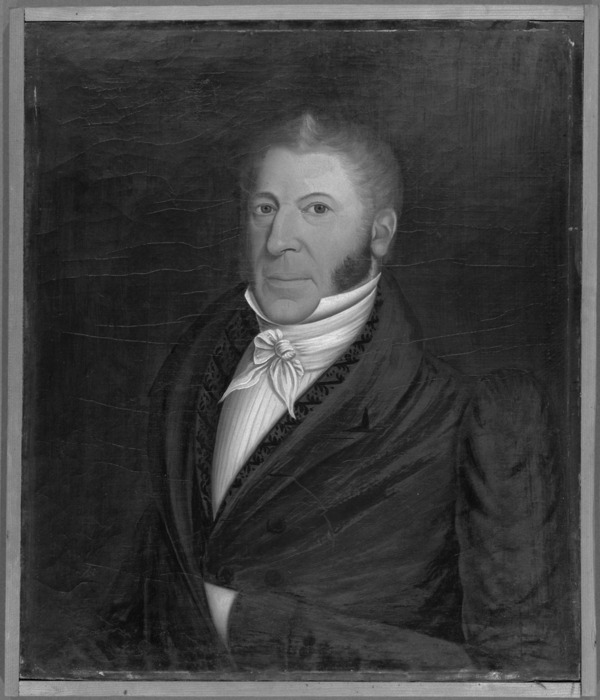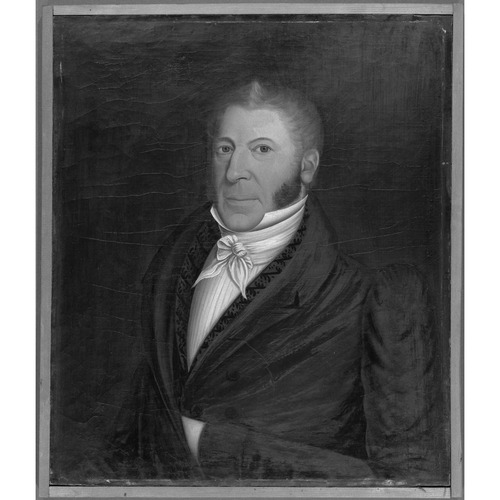FARIBAULT, JOSEPH-ÉDOUARD, notary, businessman, justice of the peace, militia officer, politician, and office holder; b. 4 May 1773 in Berthier-en-Haut (Berthierville), Que., son of Barthélemy Faribault*, a notary, and Catherine-Antoine Véronneau; d. 3 Aug. 1859 in L’Assomption, Lower Canada.
Joseph-Édouard Faribault was a clerk in his father’s office by the age of 15 and received his commission as a notary on 12 Feb. 1791. He opened an office at Berthier-en-Haut but a few months later went to practise in L’Assomption. There on 24 Nov. 1794 he married Marie-Anne-Élisabeth Poudret, the daughter of merchant Antoine Poudret and Marie-Apolline Spagniolini. Faribault carried on his profession until 1849. His minute-book contains 9,622 notarized instruments. Notaries who trained in his office include his elder brother Jean-Marie, nephew Barthélemy Joliette*, and sons Narcisse and Jacques-Eugène. Another son, Norbert, studied law under Jean-Roch Rolland* in Montreal, and a younger one, Adolphe, studied medicine in Paris, where he died in 1851.
Faribault had a good business sense, and from the time he went into practice he obtained land grants, bought lots and buildings, leased out land for farming, and made mortgage loans at six per cent or in return for annuities. But his chief occupation was to rent, build, and operate sawmills and flour-mills. Directly or indirectly he controlled almost all the mills in the vicinity, and according to Christian Roy, who wrote a history of L’Assomption, he was “the most influential man in L’Assomption between 1800 and 1845.” In addition he looked after the affairs of Paul-Roch Saint-Ours, who in 1805 chose him as attorney and agent for his seigneuries. He was the recognized administrator (of the Lavaltrie seigneury for ten years from 30 June 1812. He also built up a sizeable fortune for his daughter Aurélie, whose estate he managed; in 1837 she inherited part of the seigneuries of her first husband, Charles Saint-Ours, the seigneur of L’Assomption and of the Bayeul fief, and on the death of her second husband, Louis-Michel Viger, whom she had married in 1843, she inherited in 1855 the seigneury of Repentigny.
Faribault took part in the public life of his region. From 18 June 1808 to 2 Oct. 1809 he held the seat for Leinster in the House of Assembly. According to the classification of members drawn up by the newspaper Le Canadien in October 1809, he was among the supporters of the government, but he did not participate in any of the recorded votes of the 1809 session. In the election the following year Faribault was scrutineer for Leinster. On 2 April 1838, at the behest of Sir John Colborne*, he was appointed to the Special Council responsible for governing Lower Canada while the 1791 constitution was suspended. This council, which was dissolved by Lord Durham [Lambton*] on 1 June 1838, was re-established by Colborne in November, and Faribault, who received new commissions as a councillor on 2 Nov. 1838 and 19 Jan. 1839, remained on it until its work was completed on 10 Feb. 1841. It should be noted that he was absent when the vote approving the union of the two Canadas was taken in November 1839. Later he was active on the municipal scene, first as warden of Leinster District in 1841 and 1842, and then as mayor of L’Assomption from 1846 to 1848.
In addition to political offices Faribault held various other posts: justice of the peace for the district of Montreal (first commission in 1803), commissioner for the taking of oaths of allegiance (1812), commissioner in Leinster County for the improvement of internal communications (1817) as well as for the census (1825), and commissioner for the summary trial of small causes (1821, 1826, 1831). He was secretary of his fabrique from 1796 to 1830, and a member of the council set up at L’Assomption in 1825 to open a public primary school. However, no doubt because he was extremely cautious in business matters, he opposed the idea of founding a college put forward by Jean-Baptiste Meilleur*, and even resigned as secretary of the fabrique. Despite this reservation, in 1838 he unhesitatingly offered a substantial sum to assist the Collège de L’Assomption, which had opened five years before. Faribault served as well in the Lavaltrie battalion of militia. In 1805 he was a captain and adjutant. He was subsequently promoted major and then lieutenant-colonel, and he took part in the War of 1812; for his service he received land grants in Kilkenny Township in 1823. Some time between 1815 and 1820 he became lieutenant-colonel in command of his battalion.
In the course of his career Joseph-Édouard Faribault amassed a considerable fortune. At the time of his first wife’s death in 1828 his assets amounted to 106,332 livres, a sum he had to share with his children. On 1 Nov. 1845 he took as his second wife Geneviève Fauteux, the widow of Norbert Hénault, a merchant of Saint-Cuthbert. Stricken with apoplexy, Faribault passed away on 3 Aug. 1859 after four years of illness. He died intestate, leaving an inheritance valued at 82,216 livres, of which almost 80 per cent consisted of mortgage loans. The settlement of his estate gave rise to a long dispute between his second wife and his children which had to be resolved by arbitration. Faribault was reputed to have been a learned man, with a good legal mind, and to have had sound judgement and rare sagacity.
Joseph-Édouard Faribault’s minute-book, containing instruments notarized from 1791 to 1849, is held at ANQ-M, CN4-19. An oil portrait of Faribault by an unknown painter is in the possession of Claude Faribault of Outremont, Que.
AC, Beauharnois (Valleyfield), Minutiers, Godefroid Chagnon, 17 août 1826, 2 juin 1830, 24 juill. 1833, 4 janv. 1836; Joliette, Minutiers, J.-Z. Martel, 2 oct. 1877, 29 mars 1880. ANQ-M, CE5-1, 4 mai 1773; CE5-12, 25 sept. 1837; CE5-14, 24 nov. 1794, 10 févr. 1820, 18 oct. 1824, 28 juin 1828, 10 sept. 1843, 1er nov. 1845, 6 août 1859; CE5-16, 30 mai 1855; CN1-216, 22 janv. 1861; CN1-312, 2, 14 nov. 1859; 25 sept. 1861; CN1-313, 17 oct. 1855; CN2-29, 20 avril 1795; CN2-73, 15 mars, 6 sept., 11 nov. 1817; CN5-3, 1er nov. 1845; CN5-11, 30 juin 1812; 24 juill. 1832; 25 avril, 10 sept. 1843; CN5-24, 10 févr. 1820; CN5-30, 1er juin 1814; CN5-36, 1er nov. 1801, 1er juill. 1804, 13 janv. 1810. ANQ-MBF, CN1-60, 12 juin 1788. ANQ-Q, CN1-99, 18 oct. 1824. ASSM, 8, C, 12 juin 1797. AUM, P 58, U, Faribault à sa nièce, 20 nov. 1813. PAC, RG 1, L3L-: 995, 41096–97; RG 4, B8, 1, 12 févr. 1791; 20:7319–29; RG 8, I (C ser.), 704: 264; RG 9, I, A5, 4: 122; RG 11, A1, 10: 10–11; RG 68, 5: 58; 6: 276–77, 376, 379–80; 8: 270–71; 13: 103, 107; 16: 7–8; 17: 66–67. Émélie Berthelot-Girouard, “Les journaux d’Émélie Berthelot-Girouard,” Béatrice Chassé, édit., ANQ Rapport, 1975: 31. Quebec Gazette, 2 June 1808, 12 July 1810, 22 May 1817, 24 Sept. 1821. F.-J. Audet, “Les législateurs du Bas-Canada.” Caron, “Inv. de la corr. de Mgr Denaut,” ANQ Rapport, 1931–32: 165, 172, 181; “Inv. de la corr. de Mgr Panet,” 1934–35: 403; “Inv. de la corr. de Mgr Plessis,” 1932–33: 89, 131. Louise Dechêne, “Inventaire des documents relatifs à l’histoire du Canada conservés dans les archives de la Compagnie de Saint-Sulpice à Paris,” ANQ Rapport, 1969: 218, 249, 256. Desjardins, Guide parl., 80, 132. Officers of British forces in Canada (Irving), 183. Quebec almanac, 1805: 29, 52; 1810: 33, 63; 1815: 58, 97; 1820: 49, 56, 99; 1821: 49, 57, 115. L.-P. Audet, Histoire de l’enseignement au Québec (2v., Montréal et Toronto, 1971), 2: 32. Chapais, Cours d’hist. du Canada, 4: 209–10, 278–79. Christie, Hist. of L.C. (1866), 5: 51. Anastase Forget, Histoire du collège de L’Assomption; 1833 – un siècle – 1933 (Montréal, [1933]), 48–49, 62. Marcel Fournier, La représentation parlementaire de la région de Joliette (Joliette, Qué., 1977), 21, 141. Hélène Lafortune, “La situation de la profession notariale à L’Assomption entre 1800 et 1850” (thèse de ma, univ. de Montréal, 1981). J.-C. Robert, “L’activité économique de Barthélemy Joliette et la fondation du village d’Industrie (Joliette), 1822–1850” (thèse de ma, univ. de Montréal, 1971). C. Roy, Hist. de L’Assomption. J.-E. Roy, Hist. du notariat, 3: 18, 28. P.-G. Roy, La famille Faribault (Lévis, Qué., 1913), 18–28. F.-J. Audet, “Membres du Conseil spécial,” BRH, 7 (1901): 82–83. “La famille Faribault,” BRH, 19 (1913): 65–75. Jacques Rainville, “Vers notre tricentenaire, la famille Faribault,” Le Courrier de Berthier (Berthierville, Qué.), 9 mai 1968. J.-C. Robert, “Un seigneur entrepreneur, Barthélemy Joliette, et la fondation du village d’Industrie (Joliette), 1822–1850,”RHAF, 26 (1972–73): 376–77, 382.
Cite This Article
Marthe Faribault-Beauregard, “FARIBAULT, JOSEPH-ÉDOUARD,” in Dictionary of Canadian Biography, vol. 8, University of Toronto/Université Laval, 2003–, accessed January 5, 2025, https://www.biographi.ca/en/bio/faribault_joseph_edouard_8E.html.
The citation above shows the format for footnotes and endnotes according to the Chicago manual of style (16th edition). Information to be used in other citation formats:
| Permalink: | https://www.biographi.ca/en/bio/faribault_joseph_edouard_8E.html |
| Author of Article: | Marthe Faribault-Beauregard |
| Title of Article: | FARIBAULT, JOSEPH-ÉDOUARD |
| Publication Name: | Dictionary of Canadian Biography, vol. 8 |
| Publisher: | University of Toronto/Université Laval |
| Year of publication: | 1985 |
| Year of revision: | 1985 |
| Access Date: | January 5, 2025 |




